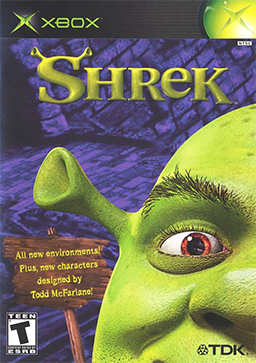Shrek (video game) facts for kids
Quick facts for kids Shrek |
|
|---|---|

North American Xbox box art
|
|
| Developer(s) | Digital Illusions Canada |
| Publisher(s) | TDK Mediactive |
| Director(s) | Gary Corriveau |
| Designer(s) | Gary Corriveau Atman Binstock |
| Programmer(s) | Atman Binstock Richard Geldreich |
| Artist(s) | Denis Cawson |
| Composer(s) | David Kerr |
| Platform(s) | Xbox, GameCube |
| Release date(s) | Xbox GameCube |
| Genre(s) | Platformer |
| Mode(s) | Single-player |
Shrek is a fun platform game released in 2001 for the Xbox. It was made by Digital Illusions Canada and published by TDK Mediactive. The game is based on the popular 2001 Shrek movie.
It came out on November 15, 2001, in North America. This made it one of the first games available for the Xbox console. Later, a new version called Shrek: Extra Large was released for the GameCube. This GameCube version came out on October 30, 2002, in North America. It used the same game style but had a different story and new levels.
Even though many people bought the game, Shrek got mixed reviews. Some players and critics did not like its gameplay or sounds very much.
Contents
How to Play Shrek
In the game, you play as the famous ogre, Shrek! Your main goal is to complete tasks called "Good Deeds." You can find these tasks in different areas. These areas are like pages in a storybook.
Shrek's Moves and Abilities
Shrek can walk, run, and jump. He can also jump off walls to reach new places. To defeat enemies, Shrek can punch, kick, or even use his flatulence (gas). Enemies will try to hurt Shrek. If he gets hurt, you can collect hearts to get his health back.
When Shrek eats onions, he gets special powers. These powers let him use more punches, kicks, or flatulence to stun enemies. If you collect enough chili peppers, Shrek can use explosive flatulence as a strong weapon! Unlike many other games, enemies in Shrek do not die. They just get knocked out for a short time.
Game Story: Shrek's Adventure
The game's story is different from the Shrek movie. It takes place after the movie. Shrek has returned to his swamp. He has become a hero to the fairy tale creatures.
Saving Princess Fiona
One day, the Magic Mirror tells Shrek bad news. His wife, Princess Fiona, has been captured! An evil wizard named Merlin has taken her to his Dark Tower Fortress of Pure Evil.
To reach Merlin's fortress, Shrek must travel through the Fairy Tale Lands. But a thick fog blocks his way. The Magic Mirror explains that Shrek must complete "Good Deeds" to clear the fog. The Mirror gives Shrek a special Book of Good Deeds. It also helps him by teleporting him to places where Good Deeds are needed. Shrek must complete these tasks to save Fiona.
How the Game Was Made
The idea for the Shrek video game started in December 2000. TDK Mediactive made a deal with DreamWorks SKG. They agreed to create video games based on the Shrek movies. The first plan was to release a Game Boy game. Then, a game for a "next generation platform" would follow.
From Sandbox to Digital Illusions
In February 2001, the "next generation platform" was announced as the Xbox. The company Sandbox Studios was chosen to develop the game. They planned to use characters and objects directly from the Shrek movie.
In April, Digital Illusions CE bought Sandbox Studios. The company was then renamed Digital Illusions Canada. Even with this change, the game stayed on schedule.
GameCube Version and Beyond
Soon after the Xbox game came out, TDK Mediactive announced a Shrek game for the GameCube. In December, it was confirmed that Digital Illusions would make this GameCube version. It was released in 2002.
There were also plans for a PlayStation 2 version. However, this PlayStation 2 game was never officially released. This was likely because Take-Two Interactive bought TDK Mediactive's US operations in 2003. After this, they no longer had the rights to make Shrek games.
See also
 In Spanish: Shrek (videojuego) para niños
In Spanish: Shrek (videojuego) para niños

